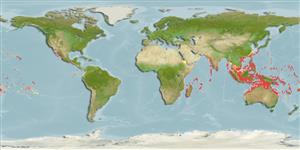>
Kurtiformes (Nurseryfishes, cardinalfishes.) >
Apogonidae (Cardinalfishes) > Pseudamiinae
Etymology: Pseudamia: Greek, pseudes = false + Greek, amia = a kind of shark (Ref. 45335).
More on author: Smith.
Environment: milieu / climate zone / depth range / distribution range
Ecologie
marien rifbewoner; diepte 1 - 64 m (Ref. 526), usually 1 - 40 m (Ref. 37816). Tropical; 30°N - 30°S
Indo-Pacific: Red Sea and East Africa to French Polynesia, north to Ryukyu Islands, south to Sydney Harbor, New South Wales (Australia). Not yet reported from the Persian Gulf, India, Malaysia, Lord Howe Island, Hawaiian Islands, Marquesas Islands, Pitcairn Group, and Easter Island (Ref. 526). Recently recorded from India (Ref. 45255).
Grootte / Gewicht / Leeftijd
Maturity: Lm ? range ? - ? cm
Max length : 11.0 cm TL mannelijk / geslacht onbekend; (Ref. 48635)
Dorsale stekels (totaal) : 7; Dorsale zachte stralen (totaal) : 8; Anale stekels: 2; Anale zachte stralen: 8; Wervels: 24. This species is distinguished by the following characters: dorsal fin rays VI-I, 9; anal fin rays II, 8; pectoral fin rays 15; pelvic fin rays I, 5; pored lateral line scales 35; predorsal scales 5-6; circumpeduncular scales 12; total gill rakers 11, developed gill rakers 8 (Ref. 093839); body translucent when fresh; sides and ventral part of head light golden to silvery iridescent; head and body with large brown spots with golden dot on the center; dusky peritoneum with numerous black dots. Anterior nostril with long, darkly pigmented membranous flap. Dorsal part of caudal fin sometimes with an indistinct dark spot. 39-43 scales in longitudinal series. This species has fewer gill rakers and anal fin rays than P. amblyuroptera (Ref. 37816).
Inhabits protected bays and lagoon reefs. Lives deep in coral thickets, thus is seldom seen by day (mainly nocturnal). Solitary (Ref 90102).
Levenscyclus en paargedrag
Maturiteit | Voortplanting | Paaien | Eieren | Fecunditeit | Larven
Distinct pairing during courtship and spawning (Ref. 205).
Randall, J.E., E.A. Lachner and T.H. Fraser, 1985. Revision of the Indo-Pacific apogonid fish genus Pseudamia, with descriptions of three new species. Indo-Pac. Fish. 6:1-23. (Ref. 526)
Status op de Rode Lijst van het IUCN (Ref. 130435: Version 2024-1)
Gevaar voor de mens
Harmless
Gebruik door de mens
Tools
Speciale rapporten
Download XML
Internetbronnen
Estimates based on models
Preferred temperature (Ref.
123201): 24.7 - 29, mean 27.6 °C (based on 1302 cells).
Fylogenetische diversiteitsindex (Ref.
82804): PD
50 = 0.5078 [Uniqueness, from 0.5 = low to 2.0 = high].
Bayesian length-weight: a=0.00389 (0.00180 - 0.00842), b=3.12 (2.94 - 3.30), in cm total length, based on all LWR estimates for this body shape (Ref.
93245).
Trofisch niveau (Ref.
69278): 3.5 ±0.5 se; based on size and trophs of closest relatives
Weerstandsvermogen (Ref.
120179): Hoog, minimale populatieverdubbelingstijd minder dan 15 maanden (Preliminary K or Fecundity.).
Fishing Vulnerability (Ref.
59153): Low vulnerability (10 of 100).
Nutrients (Ref.
124155): Calcium = 150 [79, 251] mg/100g; Iron = 0.919 [0.538, 1.554] mg/100g; Protein = 18.6 [17.4, 19.6] %; Omega3 = 0.114 [0.065, 0.208] g/100g; Selenium = 37.7 [18.0, 80.9] μg/100g; VitaminA = 82.5 [26.7, 245.2] μg/100g; Zinc = 1.88 [1.22, 2.75] mg/100g (wet weight);
